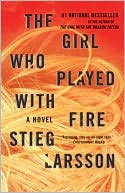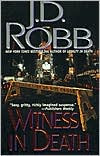 The Sea of Monsters (Percy Jackson and the Olympians #2)
The Sea of Monsters (Percy Jackson and the Olympians #2)Wednesday, March 31, 2010
It doesn't take two eyes to see the excitement!
 The Sea of Monsters (Percy Jackson and the Olympians #2)
The Sea of Monsters (Percy Jackson and the Olympians #2)Vampires that lack bite
 Bloodsucking Fiends
Bloodsucking FiendsWhether it be tattoos or fire, Salander is HOT
 The Girl Who Played With Fire (Millennium Trilogy #2)
The Girl Who Played With Fire (Millennium Trilogy #2)Monday, March 29, 2010
All the world's a stage
 Witness in Death (in Death #10)
Witness in Death (in Death #10)Wednesday, March 17, 2010
Overfishing, habitat destruction, and now a deadly virus - a sea turtle FML
 Fire in the Turtle House
Fire in the Turtle HouseI have been fortunate enough to swim with sea turtles; aside from seeing several at a distance on my various adventures to the Bahamas, I swam with a large green turtle for an extended period of time. This gentle giant gracefully glided through the turquoise waters, dodging large outcroppings of coral as he moseyed on his way. I kept a safe distance (harassing endangered species isn't really my thing) but after about 15 minutes, I apparently got a little too close for comfort and he took off with a speed that was beguiled by his bulk. I have encountered many marine creatures but, to this day, swimming with this prehistoric relic remains a highlight for me.
I have known for some time that the fate of sea turtles is in the balance - overfishing for consumption and sale on the black market, unfortunate by-catch of commercial fisheries, urban sprawl that affects nesting sites, and the shocking decline of their habitat (appropriately named turtle grass) have all combined to form a near insurmountable challenge for turtles that were once so abundant that ships had to stop and wait for groups of them to pass. What I didn't know was that a deadly virus can be added to these myriad threats.
Fibropapilloma virus (FP) entered the turtle scene with a splash in the 1970's when George Balazs too notice in the coastal waters of Hawaii. He meticulously tracked down the first documented occurrence of the tumors and then dedicated his life to determining the cause of the tumors, how they are transmitted, and what we can do to help. Fire in the Turtle House tells the story of FP from discovery through present day through the eyes of the scientists and volunteers who don't want to see this endangered species disappear for good.
I really love Davidson's writing style. I have also read The Enchanted Braid, and was once again struck by his unique ability to weave together stories of scientific research, historical anecdotes re: turtles and related species, and manage to thread honest emotion through it all. I also enjoyed that the book tells the story of FP but it also subtly reveals how scientific research is done: observation of tumors, hypothesis as to the cause, careful experimentation to support or reject the hypothesis, collaborations to conduct more complex research, workshops and meetings to discuss the findings and their implications, the dissemination of information, and finally large projects to protect the turtles based on sound science.
If you are interested in sea turtles, or marine epidemics, I whole-heartedly recommend this book. If you are simply interested in reading a science book that is fantastically written, then I whole-heartedly recommend Osha Gray Davidson!
Thursday, March 11, 2010
A better title: Specific areas of the world without us
 The World Without Us
The World Without UsA rare clear and concise explanation of a complex scientific theory
 Why Evolution is True
Why Evolution is TrueIf you are a supporter of evolution but want to learn more, are unsure on the issue but would like more facts, or are even staunchly against evolution but think it's important to know the opposition, then I would highly recommend this book.
Nancy Drew + Sherlock Holmes = Flavia de Luce
 The Sweetness at the Bottom of the Pie
The Sweetness at the Bottom of the PieMayan culture plus Amazon tribes equals more energy than a cold-fusion reaction
 Black Rain
Black Rain




